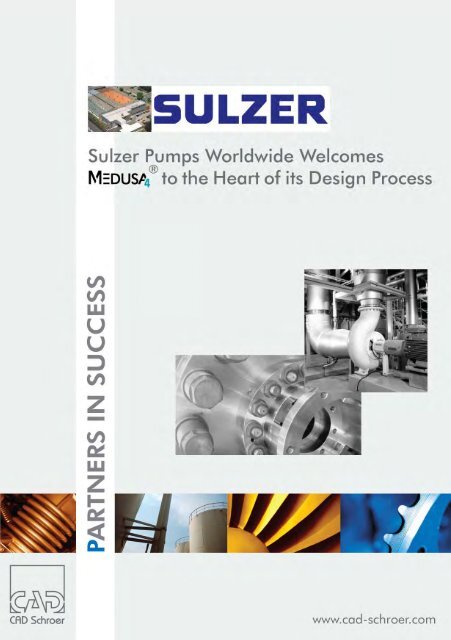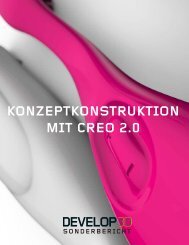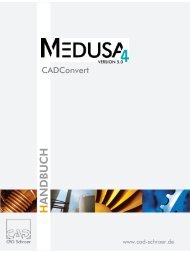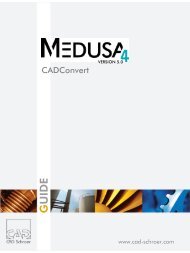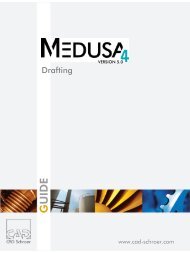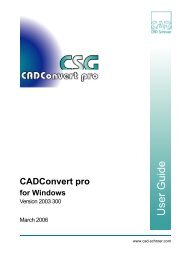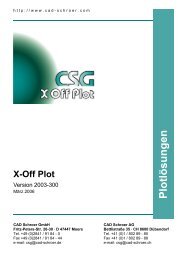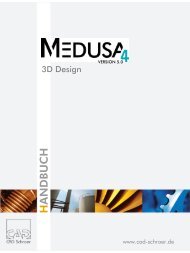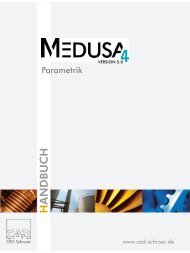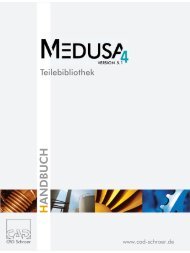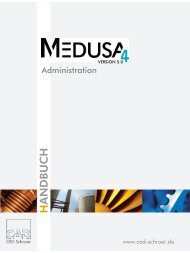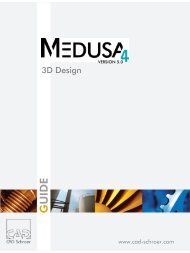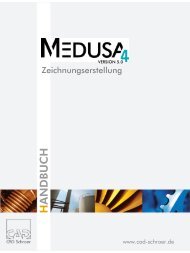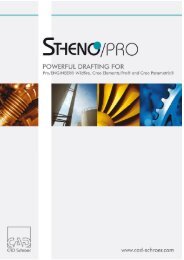Design: Sulzer Pumps - CAD Schroer
Design: Sulzer Pumps - CAD Schroer
Design: Sulzer Pumps - CAD Schroer
Create successful ePaper yourself
Turn your PDF publications into a flip-book with our unique Google optimized e-Paper software.
• Divisional HQ<br />
• Manufacturing Facilities<br />
• Customer Support Centre<br />
• Sales Office<br />
<strong>Sulzer</strong> <strong>Pumps</strong> Worldwide<br />
Image: <strong>Sulzer</strong> Corp.<br />
When it’s time to innovate, it’s all hands to<br />
the pump at <strong>Sulzer</strong>’s product research and<br />
development centres. The company’s<br />
pumping solutions underpin the businesses of<br />
clients in industry sectors as diverse as Oil &<br />
Gas, Hydrocarbon Processing (HPI), Pulp &<br />
Paper, Power Generation, Water &<br />
Wastewater, and Food, Metals & Fertilizers.<br />
<strong>Sulzer</strong> <strong>Pumps</strong>’ products, as the corporate<br />
strapline proclaims, are at the heart of its<br />
customers’ process. And MEDUSA has been at<br />
the heart of the company’s product design<br />
and development since 1985, helping to<br />
create a hugely profitable business through its<br />
extensive design automation capabilities.<br />
These have saved so much time and resource<br />
that the number of <strong>CAD</strong> engineers at <strong>Sulzer</strong><br />
<strong>Pumps</strong> today, in spite of an exponential<br />
growth in orders, is about the same as in the<br />
mid-80s. Twenty years on, <strong>Sulzer</strong> <strong>Pumps</strong> was<br />
one of the first customers to take the leap<br />
forward to MEDUSA4, the Fourth Generation<br />
release, and <strong>CAD</strong> <strong>Schroer</strong>’s flagship product<br />
line.<br />
About <strong>Sulzer</strong> <strong>Pumps</strong><br />
One of four core divisions of <strong>Sulzer</strong> Corporation,<br />
<strong>Sulzer</strong> <strong>Pumps</strong> is a global leader in the development<br />
and supply of centrifugal pumps, and proud of its<br />
unrelenting focus on operational and technical<br />
excellence, as well as its close relationship with<br />
customers all over the world. The company, which<br />
has been changing and adapting since 1775, is<br />
headquartered in Switzerland, with manufacturing<br />
sites (including two foundries) in Germany, the UK,<br />
France, Finland, the United States, Canada, Mexico,<br />
Brazil, South Africa, India and China. It also boasts<br />
the most extensive service network in the world, with<br />
over 60 dedicated technical support and service<br />
centres for all types of pumps and rotating<br />
equipment.<br />
<strong>Sulzer</strong> <strong>Pumps</strong> Ltd Winterthur –<br />
At the Heart of it All<br />
<strong>Sulzer</strong>’s head office in Winterthur, Switzerland, is<br />
still located in the street where Salomon <strong>Sulzer</strong>-<br />
Bernet established the <strong>Sulzer</strong> company and<br />
Winterthur’s first brass foundry 231 years ago, but<br />
the world of <strong>Sulzer</strong> <strong>Pumps</strong> today looks very<br />
different from that of the 18 th century. The advent<br />
of computers, and the MEDUSA computer aided<br />
design software in particular, allowed the company<br />
to expand and develop, creating a global player<br />
with manufacturing sites throughout the world.<br />
Today the pump division alone employs over<br />
5,100 staff members, and is experiencing an<br />
extraordinary spurt of growth, due in part to rising<br />
oil prices, and that industry’s desire to invest and<br />
innovate.<br />
This type of growth requires a <strong>CAD</strong> suite that can<br />
hold its own, flexible enough to support all design<br />
activities that new product developments demand.<br />
At the Forefront of Research and Development<br />
Its strong R&D culture has made <strong>Sulzer</strong> <strong>Pumps</strong> a<br />
leader in high-pressure applications and special<br />
materials. The Swiss office houses
<strong>Sulzer</strong> <strong>Pumps</strong>’ technical research and development<br />
team: 30 engineers, most of them MEDUSA users,<br />
who support the subsidiary companies – its primary<br />
customers – in many areas of product design.<br />
MEDUSA4 sectional drawing of a 6-stage<br />
centrifugal pump<br />
“Our main focus is on hydraulics,” explains<br />
Heike Tischler, design engineer in Switzerland,<br />
who project managed the MEDUSA4 roll-out<br />
across <strong>Sulzer</strong> <strong>Pumps</strong> worldwide. “We spend a lot<br />
of time looking at this area to improve pump<br />
performance, and continually develop our<br />
products. We also focus on mechanical<br />
development. If one of our subsidiaries sells a<br />
very specialised pump (such as an oil rig fire<br />
fighting pump, which has huge pressure<br />
requirements) then we do all of the development<br />
work here for them. In addition, we are always<br />
researching the market to discover new niches.”<br />
Hansjörg Büchler, Chief Information Officer, is in<br />
charge of “IT all”. He coordinates IT activities<br />
across all the <strong>Sulzer</strong> <strong>Pumps</strong> companies, including<br />
ERP and infrastructure issues, and had overall<br />
responsibility for the MEDUSA4 migration. “We act<br />
as special consultants to our subsidiaries, tackling<br />
challenges in custom pump projects. Our<br />
<strong>Design</strong>: <strong>Sulzer</strong> <strong>Pumps</strong><br />
engineers also act as an overflow resource where<br />
workloads demand.”<br />
From Special to Mainstream<br />
Certain R&D projects, based on customer<br />
requirements, provide the kind of useful feedback<br />
that makes it into the mainstream, creating extra<br />
value for both parties. “The Swiss office is currently<br />
developing a new range of pumps, which will<br />
expand our product portfolio”, explains Ms.<br />
Tischler. ”We are just in the process of building the<br />
testing facility here in Switzerland. We do the initial<br />
design and construction, then run through our<br />
rigorous testing cycles. Once everything is OK, we<br />
send our MEDUSA design to the subsidiary that<br />
commissioned this project, which then completes<br />
the detailed parts drawings, and sources the<br />
separate components from various <strong>Sulzer</strong> locations,<br />
as well as sub-contractors. It’s all very globalised.”<br />
The JF vertical fire pump is ready for<br />
instant operation, taking water from<br />
wells, reservoirs or other reliable<br />
sources.<br />
Image: <strong>Sulzer</strong> Corp.<br />
Small projects, which might involve the creation of<br />
a specialised pump based on an existing design,<br />
typically involve three engineers: one MEDUSA<br />
designer, one hydraulic engineer, and one FE<br />
analyst.
MEDUSA Then and Now<br />
<strong>Sulzer</strong> <strong>Pumps</strong> introduced MEDUSA in 1985, at the<br />
very beginning of mainstream <strong>CAD</strong>, and saw the<br />
product change hands several times, until it<br />
reached its spiritual home with one of its largest<br />
German resellers: 20 years on, and the Fourth<br />
Generation incarnation, MEDUSA4, released at<br />
the end of 2004, signified a kind of rebirth for one<br />
of the world’s most renowned product<br />
development solutions. It made good on<br />
<strong>CAD</strong> <strong>Schroer</strong>’s promise to a loyal customer base<br />
that its 2001 acquisition of the software would<br />
produce unsurpassed value for maintenance<br />
contributions.<br />
MEDUSA's customisability makes it easy to create<br />
company-specific tools, like <strong>Sulzer</strong> <strong>Pumps</strong>’<br />
TDs, upgraded for MEDUSA4, which allow for<br />
easy design translation into seven languages.<br />
Image: <strong>Sulzer</strong> <strong>Pumps</strong>, Winterthur<br />
Combining a Good Heart with a Fair Face<br />
“MEDUSA has always been one of the most<br />
powerful and flexible design solutions on the<br />
market, with huge automation potential through its<br />
BACIS programming language,” says Gilbert Koch,<br />
head of <strong>CAD</strong> <strong>Schroer</strong> AG in Switzerland, who led<br />
the project on the supply side. The product<br />
changed to adapt from tablet-driven design and<br />
Microvax work stations to PCs and user-interface<br />
driven engineering.<br />
After 20 years and many incarnations, <strong>CAD</strong><br />
<strong>Schroer</strong> Group (CSG) decided it was time to<br />
completely modernise the system, give it a fresh<br />
user interface and develop a whole new raft of<br />
productivity solutions for 21 st century design, while<br />
also introducing the kind of simplicity and ease of<br />
use customers have come to expect from off-theshelf<br />
products.<br />
“With MEDUSA4, we signalled to loyal and new<br />
customers that we are ready for the next<br />
millennium,” says Gilbert Koch. “Other than<br />
completely refreshing the user interface and greatly<br />
improving speed and performance, access to<br />
power tools, and many ways to make central<br />
administration and QA a breeze, technical<br />
innovations included click-and-drag design editing<br />
tools which do not rely on full constraints (SMART<br />
Edit), lots of quick and intuitive drag and drop<br />
functionality, and easy group structuring any time<br />
in the design process. Really, there’s too much to<br />
mention here.” The MEDUSA4 product suite covers<br />
2D drafting and Parametrics, powerful “sheetbased”<br />
3D modelling, 2D to 3D Plant <strong>Design</strong> and<br />
Factory Layout, Electrical <strong>Design</strong>, and a huge<br />
number of add-on options, from standard parts<br />
libraries to SAP ® or Pro/ENGINEER ® interfaces.
Getting Ready<br />
<strong>Sulzer</strong> <strong>Pumps</strong> was one of the first customers to<br />
recognise the overwhelming benefits of the latest<br />
release, and proceed with its worldwide<br />
migration. HQ in Winterthur develops and<br />
implements the company’s global IT strategy, and<br />
managed the MEDUSA4 upgrade and<br />
international roll-out.<br />
“We didn’t take up every new revision or version of<br />
MEDUSA that was released,” says Heike Tischler,<br />
“But I first went to an M4 workshop, then <strong>CAD</strong><br />
<strong>Schroer</strong> came to present the new version, and we<br />
were all very impressed. There was a lot of extra<br />
functionality, the user interface was drastically<br />
improved, and it was much easier to use. The<br />
DWG format support was also comprehensive and<br />
in line with the latest Auto<strong>CAD</strong> ® version, which is<br />
important when we deal with customer data.”<br />
Mr Büchler saw the upgrade as a great<br />
opportunity to do some stocktaking and<br />
housekeeping. “We did an analysis focusing on<br />
how we work today, and got rid of all the<br />
unnecessary clutter, exploring how to best take<br />
advantage of all the benefits of the new system,<br />
for example by porting our existing Bacis1 code to<br />
Bacis2, meaning all the old text-entry macros were<br />
replaced by user-friendly dialogs, which our<br />
designers really appreciate.”<br />
<strong>CAD</strong> <strong>Schroer</strong> had been commissioned to do the<br />
initial requirements analysis, “and they provided a<br />
framework for the migration, setting out how we<br />
should best go about it, and how we should<br />
prepare for it. That was very well organised,” says<br />
Ms Tischler.<br />
CSG’s consultants also rewrote or ported existing<br />
customisations, some of which completely<br />
automate the design creation process, and<br />
developed specific tools requested by various<br />
locations, which were then rolled into the central<br />
package.<br />
<strong>Sulzer</strong> <strong>Pumps</strong> tests its products in specialised<br />
testing facilities. The one pictured above is in<br />
Germany; the biggest one is in Leeds in the UK,<br />
where a steam turbine enables tests up to 30MW.<br />
Image: A. Adams<br />
Achim Maihöfer, <strong>CAD</strong> <strong>Schroer</strong>’s chief consultant on<br />
the project, developed a tool enabling designers to<br />
select a whole series of half symmetrical dimensions<br />
(displayed from the centre line) and automatically<br />
shorten them as much as possible in order to create<br />
clearer, more legible drawings. Alternatively, users<br />
can move them manually.<br />
“<strong>CAD</strong> <strong>Schroer</strong> also improved our existing TD<br />
functionality,” explains Heike Tischler, “This is a very<br />
useful tool we were able to develop as an extension<br />
to MEDUSA, allowing us to easily produce designs in<br />
seven languages.” TDs are symbols, which are made<br />
up of 2 parts; one graphical, the other text. Each<br />
symbol ID identifies the text as belonging to a<br />
specific language, so that users can translate<br />
drawings by exchanging the symbols.
Building Bridges<br />
Each company in the <strong>Sulzer</strong> <strong>Pumps</strong> family uses<br />
MEDUSA for slightly different requirements. “Here<br />
in Switzerland we focus on R & D,” explains Heike<br />
Tischler, “while the German design office, for<br />
example, does its work based on customer orders.”<br />
Pictured by a Feed<br />
Charge Pump (type GSG)<br />
manufactured in<br />
Germany for a diesel<br />
hydrofining unit in China,<br />
from left to right: Mr.<br />
Reichert, Mr. Hasenfus<br />
and Mr. Pfeiffer of <strong>Sulzer</strong><br />
<strong>Pumps</strong> in Germany with<br />
Mr. Koch of <strong>CAD</strong> <strong>Schroer</strong><br />
AG Switzerland.<br />
Right: A MEDUSA4<br />
general arrangement<br />
drawing of a centrifugal<br />
pump.<br />
<strong>Design</strong>: <strong>Sulzer</strong> <strong>Pumps</strong><br />
Nevertheless the aim of the project, as Hansjoerg<br />
Büchler points out, was to standardise as much as<br />
possible, and specialise only where absolutely<br />
necessary.<br />
“This is where our expertise is highly relevant,” says<br />
Achim Maihöfer. “As external consultants speaking to<br />
various stakeholders in <strong>Sulzer</strong> <strong>Pumps</strong>, we are able to<br />
see where<br />
departmental/geographical<br />
requirements differ, and how<br />
to best consolidate those<br />
requirements technically.<br />
Often, we are able to build<br />
bridges between different ways<br />
of working, and simplify<br />
processes via specific<br />
customisations.” Different<br />
locations may, for example,<br />
adhere to different release<br />
mechanisms, use different<br />
numbering schemes for<br />
drawings, or need different<br />
sheet header information.<br />
Providing solutions that suit<br />
most locations, without too<br />
much specialised<br />
development, means less<br />
administrative and<br />
maintenance overheads. “The<br />
key is to understand company<br />
needs on a strategic as well as<br />
operational level,” adds<br />
Gilbert Koch.<br />
Images: A. Adams<br />
Rolling it Out<br />
When Swiss headquarters<br />
rolled out MEDUSA4<br />
across its <strong>Sulzer</strong> <strong>Pumps</strong><br />
locations, the upgrade<br />
affected 27 floating<br />
licenses in Germany, 21 in<br />
the UK, 13 in Brazil, 7 in<br />
France, 7 in Canada, 6 in<br />
<strong>Sulzer</strong> <strong>Pumps</strong> Worldwide Welcomes MEDUSA4
Switzerland, 4 in South Africa, and 3 in India. The<br />
licenses are used by around 120 engineers. The<br />
roll-out across the subsidiaries went very<br />
smoothly, with both Ms Tischler and Mr Büchler<br />
lauding the close working relationship with CSG’s<br />
Swiss office.<br />
“We built the whole installation pack here in<br />
Switzerland, then made the software available to<br />
all countries, so that the roll-out took place more<br />
or less simultaneously, really without any hitches,”<br />
says Mr Büchler.<br />
“We were very satisfied with the migration process,<br />
and the support we received from <strong>CAD</strong> <strong>Schroer</strong>,<br />
especially Mr Maihöfer, really was great. And to this<br />
day his colleague Heinz Wegmann is helping us out<br />
with user advice, which we very much appreciate,”<br />
adds Heike Tischler.<br />
The Proof of the Pudding<br />
But the proof of the pudding, as they say, is in the<br />
eating, and a major new software release means<br />
change, and none of us like change, especially<br />
designers who have been working with a system<br />
comfortably for nearly 20 years; know its ins and<br />
outs, and have their special way of working.<br />
“Everyone really likes the new user interface,<br />
which makes so many things simpler than before,”<br />
says Ms Tischler. “Of course it takes some time<br />
for users to adapt to some of the new, and<br />
particularly changed, functionality.”<br />
She cites the case of the new group structure<br />
concept, which she loves, because it enables here<br />
to simply start drawing, and then add structure<br />
later. “And it’s so much easier now, the Explorerstyle<br />
ability to click and drag.” Still, some<br />
colleagues, who disciplined themselves to group<br />
their components during design creation, may<br />
mourn the old clump structure for a while.<br />
“Newer users, or those with an Auto<strong>CAD</strong><br />
background, like myself, don’t have any issues<br />
with concepts that allow designers just to go wild<br />
4 to the Heart of its <strong>Design</strong> Process<br />
and start drawing, then add structure later – and<br />
of course there are so many additional things one<br />
simply couldn’t do in Auto<strong>CAD</strong>,” adds Ms<br />
Tischler.<br />
A typical general arrangement drawing of a<br />
pump, coupling and motor with additional<br />
information such as mass, mass of rotating<br />
parts and moments of inertia<br />
<strong>Design</strong>: <strong>Sulzer</strong> <strong>Pumps</strong><br />
“That’s a very normal, if not always easy, situation<br />
when you have a major software upgrade,” says<br />
Gilbert Koch. “Those people that use MEDUSA every<br />
day find it easy to adapt, and we run workshops<br />
where we follow up our training with some personal<br />
hand-holding – often it’s a simple thing – showing<br />
someone how to do something quicker – that makes<br />
all the difference.” We visited one of <strong>Sulzer</strong> <strong>Pumps</strong>’<br />
largest subsidiaries to find out how the migration<br />
worked for them.
A Case in Point: <strong>Sulzer</strong> <strong>Pumps</strong> Germany<br />
The German location, in Bruchsal, near Karlsruhe,<br />
one of <strong>Sulzer</strong> <strong>Pumps</strong>’ top manufacturing facilities,<br />
designs and builds custom pumps for global projects,<br />
and employs 300 people, with around 200 white<br />
collar and 100 highly trained factory staff. At the<br />
Bruchsal site, there are around 35-40 people<br />
involved with <strong>CAD</strong>, amongst them 35 MEDUSA users,<br />
who share 27 concurrent licenses.<br />
Bernd Günter Pfeiffer is the company’s IT Manager,<br />
supported by Winfried Reichert, Technical Data<br />
Processing and Network Manager, who, together with<br />
one of their chief product development engineers,<br />
Georg Hasenfus, managed the MEDUSA4 migration<br />
project in Germany, in close cooperation with<br />
Ms Tischler at HQ in Switzerland. Mr Hasenfus was<br />
one of the first people to receive MEDUSA user<br />
training when the software was introduced about 20<br />
years ago, and it was his job back then to train other<br />
users. Together, the gentlemen explain what the<br />
German company does, and how MEDUSA is critical<br />
to their work.<br />
<strong>Pumps</strong> by <strong>Design</strong><br />
“We focus on pre-engineered pumps, created from a<br />
catalogue of variants, which are customised to suit<br />
individual requirements, mostly for hydrocarbon<br />
processing and power generation applications,”<br />
explains Mr Pfeiffer. Unlike some other German firms,<br />
<strong>Sulzer</strong> <strong>Pumps</strong>’ business is booming and staff numbers<br />
growing: “80% of our products head for export<br />
markets.”<br />
Its product list is impressive and expanding, as the<br />
company fosters organic growth, as well as<br />
acquiring key players in niche markets, such as the<br />
2006 purchase of Crown <strong>Pumps</strong>, Texas, which<br />
specialises in submersible vertical turbine pumps.<br />
<strong>Sulzer</strong> now offers over 46 different series of pumps,<br />
ranging from single stage to barrel, to ring section,<br />
to axial split and vertical pumps.<br />
Its business is based on orders received from<br />
intermediary installation design firms, which<br />
typically provide the complete package (e.g.<br />
complete fire fighting installations for oil rigs) to<br />
the end customer.<br />
Net sales in Germany have been very strong, with<br />
2006 proving to be a bumper year. <strong>Pumps</strong> only make<br />
up 50% of sales; the other half comes from<br />
maintenance and consultancy services. In 2005 the<br />
German firm manufactured 721 pumps; many of<br />
which run into the tens and hundreds of thousands of<br />
Euros in cost. <strong>Sulzer</strong> <strong>Pumps</strong>’ overall sales were up<br />
over 26.4% in 2005 compared with 2004, with a<br />
55.4% increase in operating income.<br />
Projects of all Sizes<br />
“Ours is not a mass market product,” explains<br />
Mr Reichert, “We very much work on a<br />
project basis. Our customers define the extent of<br />
the order – which is usually an aggregate including<br />
the pump, the motor (these we buy in based on<br />
customer specifications), seals, couplings, coolers<br />
etc. Sometimes all we get from them is a drawing<br />
title block with a logo. Sometimes we get an<br />
installation framework. In terms of P&IDs, there are<br />
often prescribed numbering systems, and the seal<br />
or motor suppliers provide us with some basic data,<br />
which we process with our MEDUSA drawings. End<br />
customers want their documentation in various<br />
<strong>CAD</strong> formats. This was one of the reasons for<br />
upgrading to MEDUSA4 – its excellent data<br />
exchange capabilities with Auto<strong>CAD</strong> and other<br />
systems.”<br />
Mr Hasenfus adds, “There is really never a case<br />
when a standard pump doesn’t have to be<br />
customised in some way or another, even if it’s just<br />
an installation diagram, or a new motor added to<br />
the aggregate.”<br />
Projects can take from 5-6 months for small pumps,<br />
to several years for large projects.
The ESCRAVOS Project<br />
The largest project currently under way is called<br />
ESCRAVOS. It involves oil fields in Nigeria, where<br />
Chevron is building a new refinery to process the<br />
gases created during the oil extraction process. In<br />
the past this gas was often burned, but in<br />
accordance with the Kioto Protocol, and<br />
supported by higher oil prices, Chevron will now<br />
be using state of the art technology to turn the<br />
gas into liquid form and transport it to a large<br />
refinery, where it is turned into petrol. <strong>Sulzer</strong><br />
<strong>Pumps</strong> is the main pump supplier for the refinery,<br />
as well as for the network of pipelines which will<br />
carry the gas from the oil fields to the plant.<br />
Circulation pump AHLSTAR APP<br />
pumping black liquor in the evaporation<br />
plant of a chemical pulp mill<br />
To the right: MEDUSA4 sectional<br />
drawing of a similar pump<br />
Image: <strong>Sulzer</strong> Corp.<br />
“It is a truly global project,” says Mr. Pfeiffer, “We<br />
have nine full time staff members working on<br />
ESCRAVOS over a 2-year period, and we’ve hired<br />
one new MEDUSA design engineer specifically for<br />
this project. We’re talking about 90 pumps, and a 20<br />
million Euro value. The majority of the pumps will be<br />
delivered to Nigeria straight from our factories in<br />
India, Mexico, the U.S., South Africa and the UK, but<br />
Germany is handling all the project management.”<br />
There are four large contractors involved, as are<br />
some of the world’s largest motor, seal and coupling<br />
suppliers.<br />
<strong>Design</strong>: <strong>Sulzer</strong> <strong>Pumps</strong>
MEDUSA at the Core<br />
Engineers at <strong>Sulzer</strong> <strong>Pumps</strong> in Germany have been<br />
working with MEDUSA since 1985 to design new<br />
pre-engineered pumps, modify existing designs,<br />
and create complex custom pump packages for<br />
special applications.<br />
<strong>Sulzer</strong> <strong>Pumps</strong> in Bruchsal, Germany, creates custom<br />
pumps for global projects. Both the factory floor layout,<br />
and staff training are geared towards lean manufacturing,<br />
with <strong>Sulzer</strong>’s “5-S Approach” (Sort, Straighten,<br />
Shine, Sense for order, Self-discipline) resulting in an<br />
uncluttered, highly efficient working environment<br />
When orders are received, MEDUSA experts like<br />
Mr Hasenfus and Mr Luft straightaway start with the<br />
design process, first creating a general arrangement<br />
drawing. Then existing pump designs are customised<br />
both internally and externally, taking into<br />
consideration materials, pressure requirements, the<br />
liquids they will be pumping etc. They then add<br />
pipes, seals, and other components, producing<br />
separate component drawings. Finally, the designers<br />
produce the layout and the plan view of the pump.<br />
Customers often receive basic drawings as PDFs or<br />
in paper format, along with schematic drawings like<br />
P&IDs with pump placement in order to plan for<br />
electrics, piping etc.<br />
Images: <strong>Sulzer</strong><br />
Managing Change<br />
When MEDUSA4 arrived in Germany, the<br />
changeover was relatively pain-free, as the leg<br />
work had already been done by <strong>CAD</strong> <strong>Schroer</strong> and<br />
the Swiss head office.<br />
“There were quite a few details we had to consider<br />
when integrating a standard <strong>CAD</strong> parts solution, for<br />
example,” says Achim Maihöfer, who worked<br />
closely with teams in Germany, “and we worked to<br />
ensure customers could easily benefit from the new<br />
Styles concept in MEDUSA4. We did the mappings<br />
to achieve consistent results, and also introduced<br />
special line styles required by the South African<br />
team. This iterative process ensured that drawings<br />
from all locations would convert seamlessly.”<br />
“As a result, I had no issues with design conversion<br />
whatsoever,” says Winfried Reichert. “I wanted to<br />
get our whole stock updated in one go, so I did a<br />
batch conversion. It took four to six hours on two<br />
machines to convert 80,000 drawings to<br />
MEDUSA4 – a piece of cake.”<br />
Georg Hasenfus adds, “The migration to M4 was<br />
pretty straightforward – unlike the change from<br />
tablet to screen menus! The way of working has<br />
changed fairly fundamentally, but – and we saw<br />
this during the training session – experienced<br />
MEDUSA users quickly got the hang of it.”<br />
Worldwide user training was coordinated to take<br />
place almost simultaneously, with <strong>CAD</strong> <strong>Schroer</strong><br />
providing training direct in Germany, Switzerland,<br />
and France, and via close partners in the rest of<br />
the world. MEDUSA4 Administrator courses were<br />
completed shortly beforehand, ensuring that each<br />
location had a primary contact for users and CSG<br />
Technical Support alike.<br />
“One of the things I can’t stress enough is the need<br />
for good administrator and upgrade courses for end<br />
users; especially in a case like this, where there was<br />
such a leap forward from the version of MEDUSA<br />
<strong>Sulzer</strong> <strong>Pumps</strong> had previously deployed and the new<br />
generation version,” says Gilbert Koch. “When users
learn how to best exploit new tools and functionality,<br />
productivity levels soar.”<br />
A Faint Heart Never Won Fair Lady<br />
As IT Managers know only too well, product<br />
upgrades which involve new versions with a<br />
breadth of new functionality, new possibilities and<br />
a brand new user interface, require a well<br />
thought-out strategy, especially when dealing with<br />
multiple companies and locations.<br />
Implementation teams take into consideration all<br />
aspects of the corporate infrastructure and<br />
processes, technical as well as human. The key to<br />
success lies in effective change management and<br />
communication: detailed planning and<br />
evaluation, coupled with a close, efficient<br />
partnership between the customer’s<br />
implementation team and their systems supplier.<br />
Mr Büchler’s recommendation: “I would strongly<br />
advise anyone following in our footsteps to get<br />
<strong>CAD</strong> <strong>Schroer</strong>’s consultants involved with a<br />
requirements analysis from the very beginning.<br />
Make sure that everyone in the team is singing off<br />
the same hymn sheet, and has the latest<br />
information. Then execute the project with a solid<br />
project plan with firm milestones.”<br />
At <strong>Sulzer</strong> <strong>Pumps</strong>, a challenging international rollout<br />
worked smoothly because of good planning,<br />
and excellent communication between the<br />
customer and <strong>CAD</strong> <strong>Schroer</strong>.<br />
“The move to MEDUSA4 was a great leap forward<br />
for <strong>Sulzer</strong> <strong>Pumps</strong>,” concludes Mr Büchler, ”The<br />
comprehensive design automation package,<br />
modern user interface, and a huge raft of<br />
productivity tools provides us with the efficiency and<br />
flexibility we need to meet new challenges and<br />
develop world class pumping solutions. <strong>CAD</strong><br />
<strong>Schroer</strong>’s friendly, professional support has been<br />
invaluable. With business booming, and MEDUSA4<br />
now firmly at the centre of our design processes, we<br />
can look forward with confidence to the next<br />
decades of growth and innovation.”<br />
Technical modifications reserved. © <strong>CAD</strong> <strong>Schroer</strong> GmbH.<br />
All rights reserved. All brands or product names are trademarks or<br />
registered trademarks of their respective owners.


